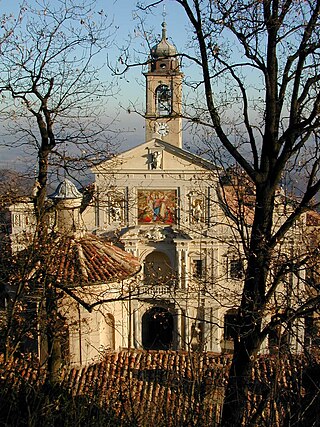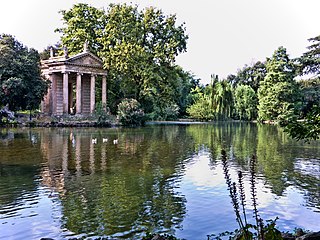
The province of Grosseto is a province in the Tuscany region of Italy. Its capital is the city of Grosseto. As of 2013 the province had a total population of 225,098 people.

Nuoro is a city and comune (municipality) in central-eastern Sardinia, Italy, situated on the slopes of Mount Ortobene. It is the capital of the province of Nuoro. With a population of 36,347 (2011), it is the sixth-largest city in Sardinia. Its frazione (borough) of Lollove is one of I Borghi più belli d'Italia.

The Quirinal Hill is one of the Seven Hills of Rome, at the north-east of the city center. It is the location of the official residence of the Italian head of state, who resides in the Quirinal Palace; by metonymy "the Quirinal" has come to stand for the Italian president. The Quirinal Palace has an extension of 1.2 million sq ft (110,000 m2).

Alcamo is the fourth-largest town and commune of the Province of Trapani, Sicily, with a population of 44.925 inhabitants. It is on the borderline with the Metropolitan City of Palermo at a distance of about 50 kilometres from Palermo and Trapani.

Livorno is a port city on the Ligurian Sea on the western coast of the Tuscany region, Italy. It is the capital of the Province of Livorno, having a population of 158,493 residents in December 2017. It is traditionally known in English as Leghorn.

Grosseto is a comune in the central Italian region of Tuscany, the capital of the province of Grosseto. The city lies 14 kilometres from the Tyrrhenian Sea, in the Maremma, at the centre of an alluvial plain on the Ombrone river.

Mondovì is a town and comune (township) in Piedmont, northern Italy, about 80 kilometres (50 mi) from Turin. The area around it is known as the Monregalese.

Monselice is a town and municipality (comune) located in northeastern Italy, in the Veneto region, in the province of Padua about 20 kilometres (12 mi) southwest of the city of Padua, at the southern edge of the Euganean Hills.
Monselice is the most picturesque town I have seen in Italy. It has an old ruin of a castle upon the hill and thence commands a beautiful and extraordinary view. It lies in the wide plain – a dead level – whereon Ferrara, Bologna, Rovigo, Este, Padua stand and even Venice we could dimly see in the horizon rising with her tiara of proud towers. What a walk and what a wide delightful picture. To Venice 38 miles. Ralph Waldo Emerson Journals

Capannori is an Italian town and comune in the province of Lucca, in northern Tuscany.

Rocca di Papa is a small town and comune (municipality) in the Metropolitan City of Rome, Lazio, Italy. It is one of the Castelli Romani about 25 kilometres (16 mi) southeast of Rome on the Alban Hills. It is close to the other communes of Velletri, Rocca Priora, Monte Compatri, Grottaferrata, Albano and Marino. It is the center of the Regional Park known as the "Parco Regionale dei Castelli Romani".

The Sacro Monte di Crea is a Roman Catholic sanctuary in the comune of Serralunga di Crea, Piedmont, northern Italy. It is reached via a steeply ascending route which winds through a wooded natural park, whose flora was catalogued by the Casalese photographer and polymath Francesco Negri.

The Shrine of Our Lady of Grace, also known as Sanctuary of Montenero, is a religious complex in Monte Nero, a village in Livorno Hills, near Livorno, central Italy reachable by a funicular.

The AMT Genova, formally known as the Azienda Mobilità e Trasporti and formerly as the Azienda Municipalizzata Trasporti, is a joint stock company that holds the concession for public transport in the Italian city of Genoa.

The Sanctuary of the Most Holy Mary of the Height is a place of Marian devotion, located on the top of Mount Bonifato, in Alcamo in the province of Trapani, Italy.

Pinciano is the 3rd quartiere of Rome (Italy), identified by the initials Q. III. The name derives from the Pincian Hill. It belongs to the Municipio II.

Azienda Trasporti Livornese, known as ATL, was a public company that managed the local public transport in Livorno and its province including Elba.

The Montenero Funicular is a funicular railway line connecting the two parts of the fraction of Montenero, Livorno in Italy.



















